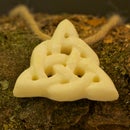Introduction: Wooden Engagement Ring
Simple `ingredients' and simple equipments to get a good looking ring.
I had a brilliant lying in a little box on my desk and I really love rings.
I decided to put that gem on a ring and to give it to my girlfriend.
But I am not a jeweler nor I have the right equipment, so I decided to use wood as raw material and to use my limited set of utensils.
I actually did not use it for a proposal, I just gave it to my girlfriend as a normal gift.
But it can be a good engagement ring for the guys that want to give something special to their lovers.
The close-up pictures were taken with a Pentax K10 D and a Tamron AF 90mm f/2.8 SP Di macro lens.
The other pictures, with a Pentax SMC-DA 16-45mm f/4 ED AL zoom lens.
I had a brilliant lying in a little box on my desk and I really love rings.
I decided to put that gem on a ring and to give it to my girlfriend.
But I am not a jeweler nor I have the right equipment, so I decided to use wood as raw material and to use my limited set of utensils.
I actually did not use it for a proposal, I just gave it to my girlfriend as a normal gift.
But it can be a good engagement ring for the guys that want to give something special to their lovers.
The close-up pictures were taken with a Pentax K10 D and a Tamron AF 90mm f/2.8 SP Di macro lens.
The other pictures, with a Pentax SMC-DA 16-45mm f/4 ED AL zoom lens.
Step 1: Materials
First of all you need a brilliant.
I found one in a ear-ring that was lying on the floor of a train station (lucky uh?).
I believe that it is a cubic zirconia gem, but I am not an expert, so as far as I know it can be a real diamond!
If you are not so lucky you can easily buy a cubic zirconia, or a real diamond, from eBay.
Sometimes cubic zirconia is referres as "synthetic diamond" or "lab created diamond".
Then you need some wood.
I used a dark-red wood, but do not ask me what kind is it. I think that it comes from an old broken wine barrel, since I found it in an old cellar.
Epoxy glue
To glue the brilliant on the wood. I hope that it will keep the brilliant in place. I also tried Cyanoacrylate glue (here in Italy "super attak") but it did not work, after a couple of days the gem fell off (fortunately I did not loose it).
I found one in a ear-ring that was lying on the floor of a train station (lucky uh?).
I believe that it is a cubic zirconia gem, but I am not an expert, so as far as I know it can be a real diamond!
If you are not so lucky you can easily buy a cubic zirconia, or a real diamond, from eBay.
Sometimes cubic zirconia is referres as "synthetic diamond" or "lab created diamond".
Then you need some wood.
I used a dark-red wood, but do not ask me what kind is it. I think that it comes from an old broken wine barrel, since I found it in an old cellar.
Epoxy glue
To glue the brilliant on the wood. I hope that it will keep the brilliant in place. I also tried Cyanoacrylate glue (here in Italy "super attak") but it did not work, after a couple of days the gem fell off (fortunately I did not loose it).
Step 2: Equipments
My equipments are:
- Very old drill.
- Drill bit for wood.
- Drill saw.
- Drill bit to scrape.
- A selection of files.
- Dremel.
- A selection of Dremel bits.
- Very old drill.
- Drill bit for wood.
- Drill saw.
- Drill bit to scrape.
- A selection of files.
- Dremel.
- A selection of Dremel bits.
Step 3: Cutting and Drilling Wood
Now that we have everything we need let us start with the preparation of the wood piece.
First of all I drilled the wood, then cutted it. I obtained a smaller piece with the hole in it.
With the saw I worked on the bit of wood to roughly scrap off the biggest part to get an approximately rounded shape.
I also tried to soak it in a diluted solution of white glue (here in Italy: "Vinavil") to make it stronger.
Unfortunately the glue did not penetrate much the wood so it was useless.
First of all I drilled the wood, then cutted it. I obtained a smaller piece with the hole in it.
With the saw I worked on the bit of wood to roughly scrap off the biggest part to get an approximately rounded shape.
I also tried to soak it in a diluted solution of white glue (here in Italy: "Vinavil") to make it stronger.
Unfortunately the glue did not penetrate much the wood so it was useless.
Step 4: Giving the Final Shape.
Using the scraping drill bit I gave a better shape to the ring.
Then using the rasp and the file I tried to make it as regular as possible.
I wanted the sides to be parallel and the width to be uniform.
Then with the file and the drill bit I rounded its width.
With the rat-tail file I rouned the inside.
Then using the rasp and the file I tried to make it as regular as possible.
I wanted the sides to be parallel and the width to be uniform.
Then with the file and the drill bit I rounded its width.
With the rat-tail file I rouned the inside.
Step 5: Preparing the Alcove for the Gem.
With the Dremel bits I prepared the alcove for the gem.
First with the high speed cutter I made a little hole to easily use the other bits.
The hole should be a little bit bigger than the brillant, we must keep the room for the glue.
With the high speed cutter, then I prepared a smaller hole in it for the tip of the gem.
First with the high speed cutter I made a little hole to easily use the other bits.
The hole should be a little bit bigger than the brillant, we must keep the room for the glue.
With the high speed cutter, then I prepared a smaller hole in it for the tip of the gem.
Step 6: Polishing
Using the polishing felt I polished the ring.
I wanted to make it dark and shiny so I set the Dremel to maximum speed.
The felt kind of burned the wood (I could actually smell burned wood) under it making it darker and polished.
Be careful not to burn it completely and to give an uniform tone to the wood.
I wanted to make it dark and shiny so I set the Dremel to maximum speed.
The felt kind of burned the wood (I could actually smell burned wood) under it making it darker and polished.
Be careful not to burn it completely and to give an uniform tone to the wood.
Step 7: Preparing the Brillant.
To easily manipulate the brillant I attached it to a piece of plasticine.
I also cleaned it with acetone, as suggesten on the glue packaging.
I also cleaned it with acetone, as suggesten on the glue packaging.
Step 8: Gluing!
With the epoxy glue I glued the gem to the ring, but I had some problems due to the plasticine: it gets in the way!
I should find a better way to handle the brillant, than the plasticine.
I should find a better way to handle the brillant, than the plasticine.
Step 9: Final Result.
I am pretty satisfied with the result, it was my first time to try to make a ring like that.
As mentioned, I should find a better way to handle the gem. The plasticine leaved some residuals on the wood.
But I loke the contrast between the shine of the brillant and the darkness of the wood, plus the constrast between the rough surface of the wood and the clean surface of the stone.
As mentioned, I should find a better way to handle the gem. The plasticine leaved some residuals on the wood.
But I loke the contrast between the shine of the brillant and the darkness of the wood, plus the constrast between the rough surface of the wood and the clean surface of the stone.




